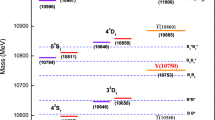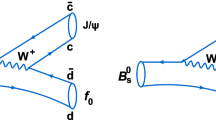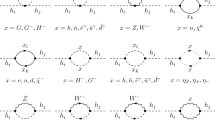Abstract
We evaluate all two-body decay modes of the heavy scalar tau in the Minimal Supersymmetric Standard Model with complex parameters (cMSSM) and no generation mixing. The evaluation is based on a full one-loop calculation of all decay channels, also including hard and soft QED radiation. The renormalization of the relevant sectors is briefly reviewed. The dependence of the heavy scalar tau decay on the relevant cMSSM parameters is analyzed numerically, including also the decay to Higgs bosons and another scalar lepton or to a tau and the lightest neutralino. We find sizable contributions to many partial decay widths and branching ratios. They are mostly of \(\mathcal{O}(5\mbox{--}10~\%)\) of the tree-level results, but can go up to 20 %. These contributions are potentially important for the correct interpretation of scalar tau decays at the LHC and, if kinematically allowed, at the ILC or CLIC. The evaluation of the branching ratios of the heavy scalar tau will be implemented into the Fortran code FeynHiggs.































Similar content being viewed by others
Notes
Scalar taus can also be produced directly at the LHC, see for instance Ref. [10], where, however, only cross sections for a lighter stau where evaluated numerically.
It should be noted that the purely loop induced decay channels \(\tilde{\tau}^{-}_{2}\to\tilde{\tau}^{-}_{1}\gamma \) have been neglected because they yield exactly zero, see Sect. 3 for further details.
The unitary matrix \({\mathbf{U}}_{\tilde{\tau}}\) can be expressed by a mixing angle and a corresponding phase. Then the counterterm δY τ can be related to the counterterms of the mixing angle and the phase (see Ref. [45]).
We consider only the cMSSM, where in the SM part the neutrino is massless and does not have any Majorana mass terms. However, the argument for not renormalizing any off-diagonal parameter is indenpendent of the nature of (s)neutrino mass terms.
Corresponding to the convention used in FeynArts/FormCalc, we exchanged in the charged part the positive Higgs fields with the negative ones, which is in contrast to Ref. [39]. As we keep the definition of the matrix \({\mathbf{M}}_{\phi^{\pm}\phi ^{\pm}}\) used in [39] the transposed matrix will appear in the expression for \({\mathbf{M}}_{H^{\pm}G^{\pm}}^{\mathrm{diag}}\).
In Ref. [61] it was also suggested that the numerically most stable result is obtained via the renormalization of one chargino and two neutralinos. However, in our approach, this choice leads to IR divergences, since the chargino mass changes (from the tree-level mass to the one-loop pole mass) by a finite shift due to the renormalization procedure. Using the shifted mass for the external chargino, but the tree-level mass for internal charginos results in IR divergences. On the other hand, in general, inserting the shifted chargino mass everywhere yields UV divergences. Consequently, we stick to our choice of imposing on-shell conditions for the two charginos and one neutralino.
We found that using loop corrected Higgs boson masses in the loops leads to a UV divergent result.
From a technical point of view, the W −/G −–H − transitions have been absorbed into the respective counterterms, while the Z/G–h n transitions have been calculated explicitly.
Equation (78) has been deduced via
 (79)
(79)It should be noted that we had to use \(\overline{\mathrm {DR}}\) masses everywhere for our comparison.
As default value within FeynHiggs, μ R =m t is used.
Here and below we round most of the values to one GeV.
It should be noted that a calculation very close to threshold requires the inclusion of additional (non-relativistic) contributions, which is beyond the scope of this paper. Consequently, very close to threshold our calculation (at tree or loop level) does not provide a very accurate description of the decay width.
Again we note that we do not investigate the decays of \(\tilde{\tau }^{+}_{2}\) here, which would correspond to an analysis of \(\mathcal{CP}\)-asymmetries, which is beyond the scope of this paper.
References
H.P. Nilles, Phys. Rep. 110, 1 (1984)
H.E. Haber, G.L. Kane, Phys. Rep. 117, 75 (1985)
R. Barbieri, Riv. Nuovo Cimento 11, 1 (1988)
H. Goldberg, Phys. Rev. Lett. 50, 1419 (1983)
J. Ellis, J. Hagelin, D. Nanopoulos, K. Olive, M. Srednicki, Nucl. Phys. B 238, 453 (1984)
A. Pilaftsis, Phys. Rev. D 58, 096010 (1998). arXiv:hep-ph/9803297
A. Pilaftsis, Phys. Lett. B 435, 88 (1998). arXiv:hep-ph/9805373
A. Pilaftsis, C. Wagner, Nucl. Phys. B 553, 3 (1999). arXiv:hep-ph/9902371
S. Heinemeyer, Eur. Phys. J. C 22, 521 (2001). arXiv:hep-ph/0108059
J. Lindert, F. Steffen, M. Trenkel, J. High Energy Phys. 1108, 151 (2011). arXiv:1106.4005 [hep-ph]
G. Aad et al. (The ATLAS Collaboration) arXiv:0901.0512
G. Bayatian et al. (CMS Collaboration), J. Phys. G 34, 995 (2007)
TESLA Technical Design Report (TESLA Collaboration), Part 3, Physics at an e + e − Linear Collider. arXiv:hep-ph/0106315, see: tesla.desy.de/new_pages/TDR_CD/start.html
K. Ackermann et al. DESY-PROC-2004-01
J. Brau et al. (ILC Collaboration), ILC Reference Design Report Volume 1—Executive Summary. arXiv:0712.1950 [physics.acc-ph]
G. Aarons et al. (ILC Collaboration), International Linear Collider Reference Design Report Volume 2: Physics at the ILC. arXiv:0709.1893 [hep-ph]
E. Accomando et al. (CLIC Physics Working Group). arXiv:hep-ph/0412251; The CLIC CDR can be found at https://edms.cern.ch/document/1180032
G. Weiglein et al. (LHC/ILC Study Group), Phys. Rep. 426, 47 (2006). arXiv:hep-ph/0410364
A. De Roeck et al., Eur. Phys. J. C 66, 525 (2010). arXiv:0909.3240 [hep-ph]
A. De Roeck, J. Ellis, S. Heinemeyer, CERN Cour. 49(10), 27 (2009)
A. Bartl, H. Eberl, S. Kraml, W. Majerotto, W. Porod, A. Sopczak, Z. Phys. C 76, 549 (1997). arXiv:hep-ph/9701336
A. Bartl, H. Eberl, K. Hidaka, S. Kraml, T. Kon, W. Majerotto, W. Porod, Y. Yamada, Phys. Lett. B 460, 157 (1999). arXiv:hep-ph/9904417
A. Bartl, H. Eberl, S. Kraml, W. Majerotto, W. Porod, Eur. Phys. J. C 2, 6 (2000). arXiv:hep-ph/0002115
M. Mühlleitner, A. Djouadi, Y. Mambrini, Comput. Phys. Commun. 168, 46 (2005). arXiv:hep-ph/0311167
A. Bartl, K. Hidaka, T. Kernreiter, W. Porod, Phys. Lett. B 538, 137 (2002). arXiv:hep-ph/0204071
A. Bartl, K. Hidaka, T. Kernreiter, W. Porod, Phys. Rev. D 66, 115009 (2002). arXiv:hep-ph/0207186
L. Selbuz, Z. Aydin, Turk. J. Phys. 33, 1 (2009). arXiv:0808.2540 [hep-ph]
S. Kraml, D. Nhung, J. High Energy Phys. 0802, 061 (2008). arXiv:0712.1986 [hep-ph]
J. Guasch, W. Hollik, J. Sola, J. High Energy Phys. 0210, 040 (2002). arXiv:hep-ph/0207364
A. Arhrib, R. Benbrik, Phys. Rev. D 71, 095001 (2005). arXiv:hep-ph/0412349
H. Hlucha, H. Eberl, W. Frisch, arXiv:1104.2151 [hep-ph]
S. Choi, H.-U. Martyn, P. Zerwas, Eur. Phys. J. C 44, 175 (2005). arXiv:hep-ph/0508021
T. Gajdosik, R. Godbole, S. Kraml, J. High Energy Phys. 0409, 051 (2004). arXiv:hep-ph/0405167
H. Dreiner, O. Kittel, S. Kulkarni, A. Marold, Phys. Rev. D 83, 095012 (2011). arXiv:1011.2449 [hep-ph]
O. Kittel, A. Pilaftsis, Nucl. Phys. B 856, 682 (2012). arXiv:1108.3314 [hep-ph]
S. Heinemeyer, W. Hollik, G. Weiglein, Comput. Phys. Commun. 124, 76 (2000). arXiv:hep-ph/9812320; see www.feynhiggs.de
S. Heinemeyer, W. Hollik, G. Weiglein, Eur. Phys. J. C 9, 343 (1999). arXiv:hep-ph/9812472
G. Degrassi, S. Heinemeyer, W. Hollik, P. Slavich, G. Weiglein, Eur. Phys. J. C 28, 133 (2003). arXiv:hep-ph/0212020
M. Frank, T. Hahn, S. Heinemeyer, W. Hollik, R. Rzehak, G. Weiglein, J. High Energy Phys. 0702, 047 (2007). arXiv:hep-ph/0611326
S. Heinemeyer, H. Rzehak, C. Schappacher, Phys. Rev. D 82, 075010 (2010). arXiv:1007.0689 [hep-ph]
S. Heinemeyer, H. Rzehak, C. Schappacher, PoSCHARGED 2010, 039 (2010). arXiv:1012.4572 [hep-ph]
T. Fritzsche, S. Heinemeyer, H. Rzehak, C. Schappacher, arXiv:1111.7289 [hep-ph]
S. Heinemeyer, F.V.D. Pahlen, C. Schappacher, Eur. Phys. J. C 72, 1892 (2012). arXiv:1112.0760 [hep-ph]
S. Heinemeyer, C. Schappacher, Eur. Phys. J. C 72, 1905 (2012). arXiv:1112.2830 [hep-ph]
S. Heinemeyer, W. Hollik, H. Rzehak, G. Weiglein, Phys. Lett. B 652, 300 (2007). arXiv:0705.0746 [hep-ph]
A. Bartl, H. Eberl, K. Hidaka, S. Kraml, W. Majerotto, W. Porod, Y. Yamada, Phys. Rev. D 59, 115007 (1999). arXiv:hep-ph/9806299
A. Djouadi, P. Gambino, S. Heinemeyer, W. Hollik, C. Jünger, G. Weiglein, Phys. Rev. Lett. 78, 3626 (1997). arXiv:hep-ph/9612363
A. Djouadi, P. Gambino, S. Heinemeyer, W. Hollik, C. Jünger, G. Weiglein, Phys. Rev. D 57, 4179 (1998). arXiv:hep-ph/9710438
W. Hollik, H. Rzehak, Eur. Phys. J. C 32, 127 (2003). arXiv:hep-ph/0305328
S. Heinemeyer, W. Hollik, H. Rzehak, G. Weiglein, Eur. Phys. J. C 39, 465 (2005). arXiv:hep-ph/0411114
R. Peccei, H. Quinn, Phys. Rev. Lett. 38, 1440 (1977)
R. Peccei, H. Quinn, Phys. Rev. D 16, 1791 (1977)
S. Dimopoulos, S. Thomas, Nucl. Phys. B 465, 23 (1996). arXiv:hep-ph/9510220
D. Demir, Phys. Rev. D 60, 055006 (1999). arXiv:hep-ph/9901389
M. Carena, J. Ellis, A. Pilaftsis, C. Wagner, Nucl. Phys. B 625, 345 (2002). arXiv:hep-ph/0111245
A. Fowler, PhD Thesis, Durham University, UK, September (2010)
A. Fowler, G. Weiglein, J. High Energy Phys. 1001, 108 (2010). arXiv:0909.5165 [hep-ph]
T. Fritzsche, W. Hollik, Eur. Phys. J. C 24, 619 (2002). arXiv:hep-ph/0203159
T. Fritzsche, Diploma thesis, Institut für Theoretische Physik, Universität Karlsruhe, Germany, December (2000). See: www-itp.particle.uni-karlsruhe.de/diplomatheses.de.shtml
T. Fritzsche, PhD thesis, Cuvillier Verlag, Göttingen (2005). ISBN 3-86537-577-4
A. Chatterjee, M. Drees, S. Kulkarni, Q. Xu, arXiv:1107.5218 [hep-ph]
N. Baro, F. Boudjema, Phys. Rev. D 80, 076010 (2009). arXiv:0906.1665 [hep-ph]
J. Küblbeck, M. Böhm, A. Denner, Comput. Phys. Commun. 60, 165 (1990)
T. Hahn, Comput. Phys. Commun. 140, 418 (2001). arXiv:hep-ph/0012260
T. Hahn, C. Schappacher, Comput. Phys. Commun. 143, 54 (2002). arXiv:hep-ph/0105349. The program, the user’s guide and the MSSM model files are available via. www.feynarts.de
T. Hahn, M. Pérez-Victoria, Comput. Phys. Commun. 118, 153 (1999). arXiv:hep-ph/9807565
F. del Aguila, A. Culatti, R. Munoz Tapia, M. Perez-Victoria, Nucl. Phys. B 537, 561 (1999). arXiv:hep-ph/9806451
W. Siegel, Phys. Lett. B 84, 193 (1979)
D. Capper, D. Jones, P. van Nieuwenhuizen, Nucl. Phys. B 167, 479 (1980)
D. Stöckinger, J. High Energy Phys. 0503, 076 (2005). arXiv:hep-ph/0503129
W. Hollik, D. Stöckinger, Phys. Lett. B 634, 63 (2006). arXiv:hep-ph/0509298
A. Denner, Fortschr. Phys. 41, 307 (1993). arXiv:0709.1075 [hep-ph]
S. Dittmaier, Nucl. Phys. B 675 (2003). arXiv:0308.3246 [hep-ph]
W. Beenakker, A. Denner, Nucl. Phys. B 338, 349 (1990)
The couplings can be found in the files MSSM.ps.gz and HMix.ps.gz as Part of the FeynArts Package. [63, 64, 65]
K. Nakamura et al. (Particle Data Group), J. Phys. G 37, 075021 (2010)
LEP Higgs working group, Phys. Lett. B 565, 61 (2003). arXiv:hep-ex/0306033
LEP Higgs working group, Eur. Phys. J. C 47, 547 (2006). arXiv:hep-ex/0602042
The TEVNPH Working Group (CDF and D. Collaborations). arXiv:1203.3774 [hep-ex]
ATLAS Collaboration, arXiv:1202.1408 [hep-ex]
S. Chatrchyan et al. (CMS Collaboration), arXiv:1202.1488 [hep-ex]
J. Frere, D. Jones, S. Raby, Nucl. Phys. B 222, 11 (1983)
M. Claudson, L. Hall, I. Hinchliffe, Nucl. Phys. B 228, 501 (1983)
C. Kounnas, A. Lahanas, D. Nanopoulos, M. Quiros, Nucl. Phys. B 236, 438 (1984)
J. Gunion, H. Haber, M. Sher, Nucl. Phys. B 306, 1 (1988)
J. Casas, A. Lleyda, C. Munoz, Nucl. Phys. B 471, 3 (1996). arXiv:hep-ph/9507294
P. Langacker, N. Polonsky, Phys. Rev. D 50, 2199 (1994). arXiv:hep-ph/9403306
A. Strumia, Nucl. Phys. B 482, 24 (1996). arXiv:hep-ph/9604417
M. Dugan, B. Grinstein, L. Hall, Nucl. Phys. B 255, 413 (1985)
D. Demir, O. Lebedev, K. Olive, M. Pospelov, A. Ritz, Nucl. Phys. B 680, 339 (2004). arXiv:hep-ph/0311314
D. Chang, W. Keung, A. Pilaftsis, Phys. Rev. Lett. 82, 900 (1999). Erratum-ibid. 83, 3972 (1999). arXiv:hep-ph/9811202
A. Pilaftsis, Phys. Lett. B 471, 174 (1999). arXiv:hep-ph/9909485
O. Lebedev, K. Olive, M. Pospelov, A. Ritz, Phys. Rev. D 70, 016003 (2004). arXiv:hep-ph/0402023
W. Hollik, J. Illana, S. Rigolin, D. Stöckinger, Phys. Lett. B 416, 345 (1998). arXiv:hep-ph/9707437
W. Hollik, J. Illana, S. Rigolin, D. Stöckinger, Phys. Lett. B 425, 322 (1998). arXiv:hep-ph/9711322
P. Nath, Phys. Rev. Lett. 66, 2565 (1991)
Y. Kizukuri, N. Oshimo, Phys. Rev. D 46, 3025 (1992)
T. Ibrahim, P. Nath, Phys. Lett. B 418, 98 (1998). arXiv:hep-ph/9707409
T. Ibrahim, P. Nath, Phys. Rev. D 57, 478 (1998). Erratum-ibid. D 58, 019901 (1998); Erratum-ibid. D 60, 079903 (1998); Erratum-ibid. 60, 119901 (1999). arXiv:hep-ph/9708456
M. Brhlik, G. Good, G. Kane, Phys. Rev. D 59, 115004 (1999). arXiv:hep-ph/9810457
S. Abel, S. Khalil, O. Lebedev, Nucl. Phys. B 606, 151 (2001). arXiv:hep-ph/0103320
Y. Li, S. Profumo, M. Ramsey-Musolf, J. High Energy Phys. 1008, 062 (2010). arXiv:1006.1440 [hep-ph]
V. Barger, T. Falk, T. Han, J. Jiang, T. Li, T. Plehn, Phys. Rev. D 64, 056007 (2001). arXiv:hep-ph/0101106
Acknowledgements
We thank F. Campanario, T. Hahn, W. Hollik, O. Kittel, K. Kovarik, F. von der Pahlen, H. Rzehak and G. Weiglein for helpful discussions. We furthermore thank H. Eberl for assistance with the code SFOLD and corresponding discussions. The work of S.H. was supported in part by CICYT (grant FPA 2010-22163-C02-01) and by the Spanish MICINN’s Consolider-Ingenio 2010 Program under grant MultiDark CSD2009-00064.
Author information
Authors and Affiliations
Corresponding author
Rights and permissions
About this article
Cite this article
Heinemeyer, S., Schappacher, C. Heavy scalar tau decays in the complex MSSM: a full one-loop analysis. Eur. Phys. J. C 72, 2136 (2012). https://doi.org/10.1140/epjc/s10052-012-2136-5
Received:
Revised:
Published:
DOI: https://doi.org/10.1140/epjc/s10052-012-2136-5





